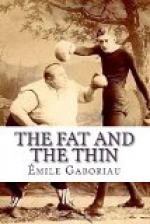The evenings were growing cold, and as soon as they had dined they retired into the kitchen, where it was very warm. The room was so large, too, that several people could sit comfortably at the square central table, without in any way impeding the work that was going on. Lighted by gas, the walls were coated with white and blue tiles to a height of some five or six feet from the floor. On the left was a great iron stove, in the three apertures of which were set three large round pots, their bottoms black with soot. At the end was a small range, which, fitted with an oven and a smoking-place, served for the broiling; and up above, over the skimming-spoons, ladles, and long-handled forks, were several numbered drawers, containing rasped bread, both fine and coarse, toasted crumbs, spices, cloves, nutmegs, and pepper. On the right, leaning heavily against the wall, was the chopping-block, a huge mass of oak, slashed and scored all over. Attached to it were several appliances, an injecting pump, a forcing-machine, and a mechanical mincer, which, with their wheels and cranks, imparted to the place an uncanny and mysterious aspect, suggesting some kitchen of the infernal regions.
Then, all round the walls upon shelves, and even under the tables, were iron pots, earthenware pans, dishes, pails, various kinds of tin utensils, a perfect battery of deep copper saucepans, and swelling funnels, racks of knives and choppers, rows of larding-pins and needles—a perfect world of greasy things. In spite of the extreme cleanliness, grease was paramount; it oozed forth from between the blue and white tiles on the wall, glistened on the red tiles of the flooring, gave a greyish glitter to the stove, and polished the edges of the chopping-block with the transparent sheen of varnished oak. And, indeed, amidst the ever-rising steam, the continuous evaporation from the three big pots, in which pork was boiling and melting, there was not a single nail from ceiling to floor from which grease did not exude.
The Quenu-Gradelles prepared nearly all their stock themselves. All that they procured from outside were the potted meats of celebrated firms, with jars of pickles and preserves, sardines, cheese, and edible snails. They consequently became very busy after September in filling the cellars which had been emptied during the summer. They continued working even after the shop had been closed for the night. Assisted by Auguste and Leon, Quenu would stuff sausages-skins, prepare hams, melt down lard, and salt the different sorts of bacon. There was a tremendous noise of cauldrons and cleavers, and the odour of cooking spread through the whole house. All this was quite independent of the daily business in fresh pork, pate de fois gras, hare patty, galantine, saveloys and black-puddings.
That evening, at about eleven o’clock, Quenu, after placing a couple of pots on the fire in order to melt down some lard, began to prepare the black-puddings. Auguste assisted him. At one corner of the square table Lisa and Augustine sat mending linen, whilst opposite to them, on the other side, with his face turned towards the fireplace, was Florent. Leon was mincing some sausage-meat on the oak block in a slow, rhythmical fashion.




